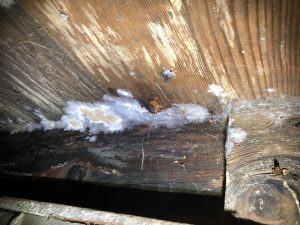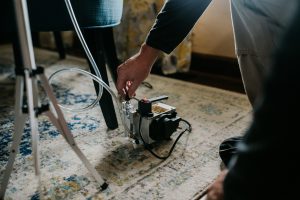The Pacific Northwest’s long, balmy summers may feel endless, but winter’s damp is – unfortunately – just around the corner. When the weather changes, people can head inside to warm blankets, dry socks and steaming coffee. But what happens when moisture creeps indoors with us? The experts at Boggs Inspection Services stress the importance of winterizing your home to keep you cozy inside and the moisture outside.

Winterize Your Home and Keep Moisture Out
The main problem with moisture inside your home is that you may not discover it right away. Even with doors and windows tightly closed for winter, there are common access points that aren’t always obvious, says Boggs Manager George Green.
“The most common is through caulking or paint that has failed on the siding or trim,” says Green. “Another pathway is through missing or damaged flashing. Anytime there is a penetration in the roof, such as a plumbing vent, appliance vent or even a chimney, there should be some sort of flashing to prevent moisture from entering the attic. Kickout flashing, which diverts water on the roof away from a wall and into a gutter, is a common point of entry if it is missing or too small.”
Flashing is described by experts as “a thin layer of waterproof material that keeps water from getting into places it doesn’t belong.” When it fails and water gets in, mold and moisture damage are a risk. Green says moisture typically shows up in attic spaces due to leaks or poor ventilation. For homes with heavily shaded roofs, attics can also harbor damp spots because the space is unable to heat up properly and remain dry.
Perform a Thorough Home Inspection Before Winter

Green and the Boggs team of inspectors recommend performing regular maintenance, especially around the caulking and paint on your home’s exterior. “Checking around the home, as well as the attic and crawl spaces, every six months is a good preventative measure to ensure moisture isn’t becoming an issue, especially after a rainy spell,” suggests Green. “This is when you will see direct evidence of moisture penetration.”
When they perform an inspection, Boggs home inspectors know that moisture issues come in various degrees of importance, Green explains. “You can have seasonal moisture intrusion under a home that can be dealt with in a few ways such as exterior drainage improvements or a water management system, like a sump pump, under the home. It’s the moisture intrusion that stems from failed or missing building components that tends to lead to mold issues.”
But damage to water pipes, gutters and toilet floor seals may be less obvious to the untrained eye. “Without proper maintenance of these systems, a potentially hazardous hidden condition may occur that affects the health of the occupants or the structural integrity of the home,” says Green. “A damaged water pipe, for instance, can completely ruin drywall within 24 hours and will create an environment for mold to grow over the next few days if gone unnoticed.”
Professional Home Inspector Can Save You Worry and Money

It’s easy to catch the obvious leaks; puddles are hard to miss! But by the time you discover discolored floorboards, walls, carpets and backyard swamps, the damage is already done. Proactively hiring a professional home inspector catches moisture problems before they’re a complex, expensive repair.
“A professional home inspector is trained to look for and identify potentially damaging defects in and around the home,” says Green. “Knowing where common issues occur and why they occur are two important reasons to hire a professional. It is important to understand that home inspectors do not perform destructive investigations. Rather, they look for external signs of water issues in and around the home.”
When you schedule an inspection with Boggs, Green suggests doing what you can to clear excessive personal belongings and plant overgrowth so inspectors can see clearly. “Making sure that as much of the property is readily available to be inspected as possible will give the inspector the best chance at finding potentially damaging issues.”
Because water damage can lead to mold and its many health-related problems, it’s important to hire someone that does the job correctly. “Professional companies that are properly trained to discover, repair or remediate moisture issues should have current licensing, bonding and insurance coverage to ensure that they are qualified to do their work,” Green shares. “Hiring companies that do not have these credentials open clients up to substandard work that can lead to more issues in the future.”

Boggs offers mold and indoor air quality testing as well as inspection packages whether buying, selling or maintaining your home. You can book a free quote and schedule online or call 360.480-9602 with questions. Inspections are performed seven days a week for your convenience and there’s information available via Facebook, Twitter, Instagram and YouTube as well as a helpful blog of tips and tricks.
We can’t do much about the rainy season but thanks to Boggs Inspections Services, you can ride it out from the warm, dry comfort of a mold- and moisture-free home. Now dig out your fuzzy slippers and the hot chocolate mix, the balmy days of autumn won’t last forever.
Sponsored

















































